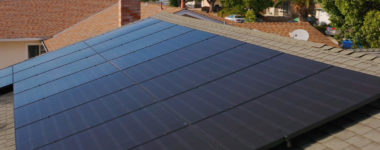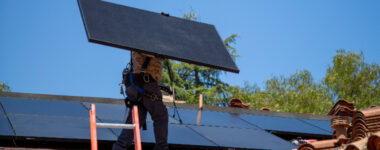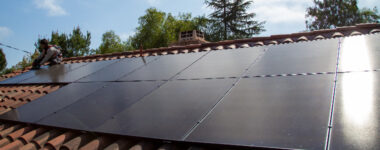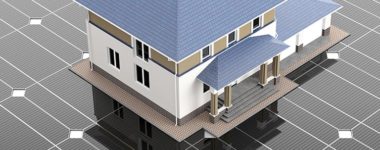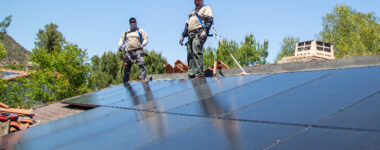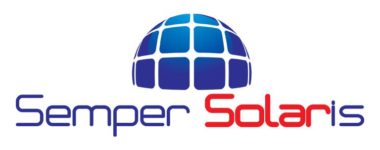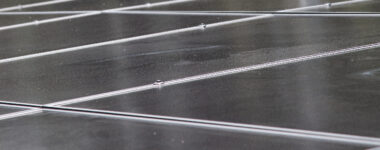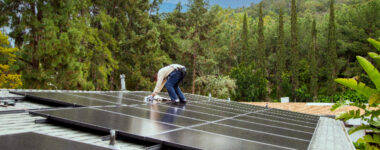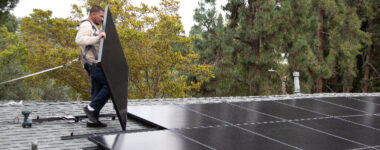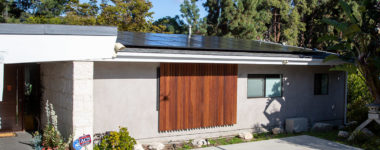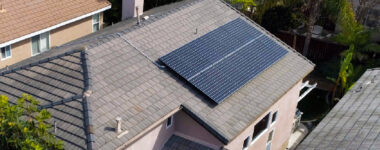Blog Post | Solar Panels, Battery Storage, Roofing, HVAC
You may have heard some buzz about how solar panels cuts costs on energy bills or that they’re eco-friendly. But chances are, this is pretty much all you know about them - and that’s 100% okay. But it’s important to understand exactly what you’re getting into when it comes to making the switch to solar energy. What Are Interesting Facts About Solar Energy? Here are 10 interesting facts about solar energy: 1. The first solar panel cell was invented in 1941 In 1839, Alexandre Edmond Becquerel discovered the photovoltaic effect—that is, the ability to create an electric current from the sun’s rays. Shortly after, Russell Ohl invented the first solar panel cell in 1941 and the first commercial panel was put out by Bell Laboratories in 1954. Today, solar panel history is still being paved, as Semper Solaris continues to install industry-leading solar panels every day. 2. One hour of sunlight equals one year’s worth of energy for the entire earth Solar power starts with solar energy, which is energy produced by the sun. When the sunbeams, its energy can be stored in solar panels. These solar panels transform energy into power in two different ways – photovoltaic, which is power used for electricity, and solar thermal, which is power used for heating. The energy from the sun is the most abundant energy source available on Earth. With just one hour of direct sunlight, you could collect enough energy to generate a year’s worth of power for the entire Earth. There’s a lot of electrical juice from the sun! All you need is a cord (aka, solar panels) that’ll transform the energy from point A (the sun) to point B (electricity that can be used by your home) to power up all your home energy requirements. Everything that you need to know about solar: Solar for Beginners! 3. California is the biggest proponent of solar energy in the United States As of 2022, California’s solar power usage topped all other states, clocking in 39,729 megawatts of solar energy use. The state has enough solar energy systems installed to power 10.7 million homes. Other states that follow just behind California in solar energy production and usage include North Carolina, Arizona, Nevada and New Jersey. But, as the popularity of solar power grows with increasingly affordable access, you can expect to see more states jump on board, expanding the overall market. 4. Solar panels can produce power without direct sunlight You read that right! The sun is the most abundant source of energy for solar panels to absorb and convert into power, but it doesn’t need to be direct sunlight. Solar panels can capture different parts of the sun’s light spectrum. So, if the sun’s not directly beaming on the panels - or it happens to be a cloudy day - it doesn’t mean the hues reflected from the sky aren’t being captured and utilized by the solar panel cells to produce power. 5. A solar-powered home can reduce CO2 emissions by 100 tons within 30 years Solar power translates to clean energy production and you can reduce your carbon footprint significantly by installing a home solar power system. In other words, it’s not emitting the same pollution other energy sources typically do. The average U.S. household using a solar power system would reduce emissions by approximately eight pounds of sulfur dioxide, five pounds of nitrogen oxide and more than 1,400 pounds of carbon dioxide each month. 6. Investing in solar energy can pay for itself When you switch to a solar energy system, try not to take the initial price of installation at face value, because the overall amount you save in investing in solar power is actually where the value lies. After you’ve had your solar panels installed, you will no longer have to pay a heating or electric bill and, after time, the amount you save on the electricity bill (which averages $1,300 per household annually), will pay off your initial investment of installing a solar energy system. Additionally, those who buy solar panels could be eligible for a 30% tax break and some states even allow solar power owners to sell their excess solar energy – putting more money back into your pockets. They are even relatively low maintenance and getting a check-up is affordable. 7. Solar power can fuel airplanes Solar energy goes beyond simply using solar power for home electricity purposes. It can also be utilized in vehicles. From cars to trains, and now even airplanes, more and more people are traveling using solely solar energy. This application of solar power outside homes and office buildings is just a start to the unlimited potential solar technology has in changing our everyday lives for the better. 8. Installing solar can be a community effort Solar energy is expanding from just individual systems for each home to community solar systems. The concept of shared solar fits well in the ever-growing sharing economy that has risen in popularity over the past decade. Instead of homeowners installing their own solar panels, solar systems are being installed for entire communities to use to power their homes. So, why not talk to your neighbors and see who else wants to go solar on your block? 9. Solar panels produce approximately 10 kilowatts of energy per square foot Kilowatts hours (kWh) are used to measure solar-powered electricity and most solar panels have approximately 225-watt capacities, with the ability to generate 20-watts per square foot. To put that in perspective (and human speak for those, not in the energy industry), the average home needs about 30 solar panels to meet its own energy usage requirements. 10. The number of U.S. solar power installations is 23 times higher than eight years ago Solar power continues to grow in popularity in the United States, which is currently the third-largest solar market in the world. With the price of solar energy systems getting lower, it is becoming a really appealing energy choice for Americans. There is a lot more to those solar panels than you may have known. After finding out about history about them, a bit of science behind the technology, solar energy’s current position in the market and its ability to grow, why not get on board with solar panels for your own home? The chances of using solar energy as a major power source are still growing and Semper Solaris can help you become a part of the solar movement.
The results are in. Growing 12 times faster than the rest of the country’s economy, solar and other clean-energy jobs are among the fastest growing in the market. Energy jobs are putting more Americans to work as efforts turn toward sustainability issues, a trend that’s happening with solar power companies in San Diego. In fact, according to an Energy and Employment Report for 2017, the solar industry now employs more workers than the oil, gas, and coal industries combined. Analysts see this growth in employment as a clear sign that renewable energy will soon replace fossil fuels. The renewable energy sector is producing more employment opportunities per dollar invested, giving additional evidence the smarter investment is moving away from fossil fuels. Jobs in the sustainable energy market are spread across the country, well paying, and reach both manufacturing and executive levels. Because these opportunities are diverse, solar continues to be extremely attractive for all types of professionals looking to switch careers into this lucrative market. How Solar Power Companies in San Diego Are Helping Create Jobs Semper Solaris is proud to be leading the charge in the growing renewable energy sector. We have seen incredible growth over the last few years as one of the leading solar power companies in San Diego. Coupled with this boom has been an increase in the number of troops returning from deployment in the past two decades. This is something that is near and dear to our hearts here at Semper Solaris. Why? We are a veteran-owned company that is founded on the Marine Corps motto of Semper Fidelis, or “always faithful.” That means we are faithful to our customers and employees, many of whom are veterans themselves. Why do we focus so much on creating jobs for veterans? Quite simply, we believe in providing opportunities for those who have served our country and rewarding their sacrifice. They are uniquely qualified and deserve as much opportunity as their civilian colleagues. We take pride in paving the way for employing veterans in our industry and hope that other companies step up in a similar way. We are confident that veterans make some of the most dedicated, disciplined, and faithful employees, bringing their military values to the forefront on every job. As solar power companies in San Diego continue to expand, we are determined to provide further job opportunities for troops returning home from serving our great country. Interested in joining the Semper Solaris team? Want to find out what people say about us? Connect with Semper Solaris, your leading solar power company in San Diego and California solar provider.
You’ve probably heard that going solar could save you a lot of money by cutting back on your energy cost. With California reaching solar parity in 2015, locking in solar savings now only continues to expand your potential savings. Financing programs allow for a fixed cost while the electric companies continue to charge more for energy year after year. Additionally, the initial switch to solar energy is not the only benefit of investing in solar can provide you. If you are looking for the latest life hack to make some extra money on top of your energy savings, going solar may just be the golden solution. With solar panels installed, you may be able to produce a profit from any excess energy your solar panels produce after a designated time. Sound too good to be true? It’s not. Can I Really Make a Profit from Going Solar? If you are installing solar panels, not only will you reduce your long-term electricity costs, you may be able to sell your generated electricity back to your utility company for a profit. It’s simple: if your solar array produces more energy in a month than the amount used by your household, the excess amount is sold back to your utility company. While there are restrictions in most states regarding this practice, California homeowners can take advantage of it by having the value of that electricity go towards other costs. Under the system known as Net Metering (currently used in California), net electricity costs can be reduced to zero, but cannot go any further. Once your solar panels have produced excess energy, your account will get a credit at full retail rates. When you generate a net surplus of energy after a 12-month period, you can receive payment under special utility tariffs that have been put in place. So there you have it. Save money by switching to solar, continue earning money by selling your excess back to the power company, and you can be environmentally responsible at the same time. That’s a win-win-win! Updates in Net Metering Recently, California’s Net Metering system has undergone a few changes. Our state’s net metering policy is a crucial part of what made going solar so attractive for countless homeowners across California. While the core has stayed the same, the major changes include the following: Time-of-use (TOU) rates - Now, every homeowner with solar panels will have TOU rates for electric expenses. This means the amount they pay per kWh will be dependent on their utility. Interconnection fees - Homeowners will also be required to pay a one-time “interconnection fee” when first getting their panels hooked up to the electric grid. Non-bypassable charges (NBC) - Homeowners will now be required to pay these NBCs only for the kWh of electricity provided by the utility when energy usage exceeds what is produced by their solar panels. According to the California Solar Energy Industries Association, these changes are estimated to only impact expenses by around $10 a month in comparison to the original policy. Have more questions about going solar today? We have the answers - and great savings. Call Semper Solaris now to set up your free energy analysis!
Unplug electronics that still use electricity when plugged in. Even when your television is off, it could still use over 6 watts of electricity. Plug electronics into a surge protector and switch off the protector when they aren’t in use. Who knows how much energy your appliances are using up even when you think they’re off! Wash clothes in cold water. According to EnergyStar, heating water is 90% of your washer’s energy usage. Wash all clothes in cold water whenever possible. Usually, this doesn’t affect the cleaning power. Plus, it stops clothes from fading as quickly. Use a programmable thermostat. You could save 10% per year on your heating bills by turning down your thermostat eight hours per day. Set your thermostat to 78°F when you’re not home. Don’t want to come home to a warm house? Consider new “smart thermostats” that can be programmed from your phone. That way, you can set it on your way back from the office and your home will be cool when you get there. Don’t leave the lights on. Sometimes the simplest changes can really help! Turn off lights when you leave the house—or even when you leave the room. Replace baths with showers. The average bath uses up to fifty gallons of water. That’s twice as much as a low-flow shower. You could spend half as much energy heating up your water by replacing a few baths with showers instead. Use energy-efficient light bulbs. Replacing your incandescent bulbs with CFLs or LEDs can save lots of energy. LED light bulbs only use ¼ of the energy that traditional light bulbs use. Plus, they can last 25 times longer! Use Energy Star appliances. Did you know that the U.S. EPA (Environmental Protection Agency) started a program to help you save energy? It’s called EnergyStar. And it’s saved consumers over $362 billion dollars on utility bills since it began! Replace your appliances with their recommended energy-saving appliances to start saving. Take some time outside the house. Small habits can make a big difference. Need to unwind? Consider taking a walk instead of watching TV a couple days a week. You’ll save energy while getting healthier. Check with your electricity company to see if they offer financial aid. If you meet certain income guidelines, or are part of eligible public programs, you could qualify for help. Check with your electricity provider to see if they offer programs that can lower or subsidy your bills. And the best way to lower your bill? Install solar panels! While all of these options can lower your bills, they can’t lower it as much as installing solar power. Solar energy is renewable energy that replaces the electricity you buy from the utility company. In fact, some customers even have the electric company paying them for their extra photovoltaic energy! Solar panel prices are lower than ever, while electric bills keep going up. Looking for a solar company? Get a free energy analysis from local and veteran owned Semper Solaris.
Going solar. How much does it cost? Probably one of the most complicated questions, and one that most homeowners find a hard time getting an answer for. The cost of switching to solar includes more than just the cost of a solar PV panel itself; you need to factor in the full financial investment needed to purchase, install, finance, and keep up this system over the course of its lifetime. However, the potential to save--and earn money back--must also be considered. The easiest way to factor the value of going solar is determining how much you pay for your current electricity from a local grid on a monthly basis compared to how much you can get paid for the electricity produced from PV after those initial costs are deducted over the course of the system’s lifetime. This is the amount that should matter to homeowners when they consider whether or not solar can save them money. Caught up in this big picture approach is the idea of solar grid parity. Defining Solar Grid Parity So what exactly is solar parity and how does it affect the decision to go solar? It is the point at which the amount of money needed to produce power from solar panels is either equal to or less than the cost of paying for electricity from the grid. The sooner we get to solar parity across the country, the cheaper it will continue to get. Essentially, the more people recognize the benefits of solar and choose to invest in this renewable energy source, the sooner it will become adopted across America, making energy cleaner and more affordable for homeowners. How does this work? When solar companies can buy in bulk to meet the growing consumer demand for solar panels, they can lower the cost of installation by getting better prices on materials. This also boosts investment in transmissions lines and helps the cut solar costs, which means it can meet the rising cost of electricity sooner, resulting in parity, or equality, until solar eventually becomes even cheaper. How Close Is the U.S. to Solar Parity? So what is the timeline for solar parity in America? That depends on a number of factors, with each state facing different challenges, from limited sun exposure to transmission line investment costs. The country has set a target of boosting renewable energy usage to 20% by 2040, which would likely result in solar parity nationwide. While we have some ground to cover as a country, California is leading the way as one of the 20 states at grid parity. Why California Homeowners Should Be Going Solar Now The point of parity on the grid has already been reached in California, which means installing solar panels is now more affordable than the average electricity bill homeowners have to pay off every month. Solar isn’t just an option for investing in the future of affordable energy, it can start saving homeowners money right now. The average homeowner will cut back on their costs between 20% and 40%--especially when they choose to partner with a company like Semper Solaris. With zero down and zero out of pocket, solar energy has never been more affordable and realistic for homeowners. Factors that make going solar affordable to homeowners now: 26% federal tax credit Net metering can result in money back from electricity companies California has already reached grid parity Great savings in Semper Solaris’ online specials Some properties may go months without having a bill Interest is tax deductible Low income and low FICO scores can still finance through PACE What Is PACE Financing? The PACE Financing program is a great option that makes setting up solar energy easier for homeowners, ultimately pushing us closer to solar grid parity. Short for Property Assessed Clean Energy, PACE is a financing option designed to help homeowners save money when investing in cleaner energy while adding more value to their property. PACE covers 100% of the solar installation cost and can be paid back over the course of 20-30 years, with an assessment added to the property tax bill. This also means homeowners start saving from day one! The Senate bill on PACE (SB-242) will add more consumer protections for residential PACE programs in California, providing even more peace of mind to homeowners wanting to invest in energy upgrades that wouldn’t otherwise be accessible to them. With California at solar parity, switching to solar is the smart investment for homeowners who want to instantly save on their energy bill and be a force for renewable energy. Ready to Go Solar, American Style? Semper Solaris offers zero-down solar solutions. Start with a free energy analysis!
The White House has long served as a symbol of America, and our nation’s Presidents have been careful in how they choose to decorate and present this historic monument. Not only do the President and his staff live there, but the media also often has its eye on this important place. For these symbolic reasons, as well as a few practical ones, several Presidents throughout the years have chosen to install or uninstall solar panels on the White House roof—and by doing so, to make statements about how this powerful symbol should get its power. Jimmy Carter Jimmy (James) Carter, the 39th President of the United States, was the first President to install solar panels on the White House, and he used them to heat the water for the staff kitchen. Former President Carter’s decision was certainly a symbolic one, as the solar panels were installed during the 1979 oil crisis. He shared that this move was intentional, and in a formal declaration he stated that his goal for solar energy was, “…harnessing the power of the sun to enrich our lives as we move away from our crippling dependence on foreign oil.” Ronald Reagan The president directly after Jimmy Carter, former President Ronald Reagan, did not necessarily share Carter’s views on renewable energy. According to Scientific American, Reagan decided to remove the panels when the White House roof was resurfaced, and not to put them back up. Some of the reasons were practical, according to Reagan, who believed it was not cost-effective to keep the panels up. However, some reasons were symbolic, as this was around the same time that Reagan withdrew support for renewable energy tax credits and the Department of Energy. Carter’s panels have since been moved to Unity College in Maine, the Smithsonian Museum, the Carter Library, and the Solar Science and Technology Museum in China. George W. Bush Perhaps surprisingly, the next president to reinstall solar panels on the White House was former 43rd President George W. Bush. The administration installed a nine-kilowatt photovoltaic system to produce electricity, and two solar water heaters. Unlike Carter, Bush did not issue an official declaration or state any symbolic reasons for the switch. Instead, it simply seemed like a practical decision: solar technology had now advanced, and the solar panel price had dropped far enough, that it was now more cost effective for the White House to receive some energy from solar power. Barack Obama American’s 44th President, former President Barack Obama, reinstalled solar panels at a larger scale—and with more publicity—than anyone had since Carter. “Solar panels on the White House, I think, are a really important message that solar is here, we are doing it, and we can do a lot more,” said Dr. Ernest Moniz, former Secretary of Energy for the Obama administration. Installing solar panels on the White House was a purposeful choice for Obama, who was known for his pro-renewable energy policies. The panels installed on the White House were around the same size as panels installed on the average American home. Minh Le, Director of Solar Tech at the Department of Energy, shared, “The President is basically doing what Americans all across the nation are doing right now. They’re making the conscious choice to look for renewable energy like solar as the cheaper, cleaner, and preferred energy source for their homes and families.” Interested in installing solar panels on your own home? Get a free energy analysis from local and veteran owned Semper Solaris.
Solar Parity is a complex concept most people struggle to undertsand. That is why we created this infographic to help set the record straight. We'll try to explain the ins and outs today in the hope of helping some of you to gain a better grasp of the situation.
Just last month, CBS Los Angeles reported an upcoming change in Southern California’s electricity. Southern California Edison will now be charging a “high usage fee” for customers that use four times the amount of energy than the average family in the area. At first glance, this change doesn’t seem to be a concern for most Southern California residents. However, there are several groups of people that need to be especially wary of the new charge. For example, if residents have an electric car, they may hit that high usage cap much sooner than they would expect. Homes with a family member that stays at home for most of the day, or families that need to run the air conditioning or heater often, may also use higher than average amounts of electricity and get stuck with paying the new fee. CBS noted that there are several ways to approach the new fee if you believe that you may be at risk for high energy usage. For electric vehicle users, Southern California Edison offers a time-of-use plan or an electric vehicle rate plan. These plans offer lower rates for customers that charge their vehicles during specified hours, and the electric vehicle rate plan charges a different rate specifically for the electricity used to charge your vehicle. However, these plans may not work for everyone. For customers who have an electric vehicle and also run air conditioning, for example, there may be no way to escape the high usage fee. CBS Los Angeles offered solar panel installation as a possible solution, but warned that installing solar panels could mean a high upfront cost. However, for Semper Solaris, this simply isn’t true. Installing solar panels can absolutely dramatically reduce or even eliminate your electric bill, even for those who use a large amount of electricity every month. However, Semper Solaris offers zero down, no money out of pocket solar panel installation. Rather than charge an upfront cost that many homeowners can’t afford, Semper Solaris offers financing plans that can fit each family’s needs. We can also connect homeowners with several programs that offer other financing options. The HERO Program, for example is a local government-approved program that makes energy-efficient and water-saving home upgrades affordable for homeowners. HERO offers 100% financing up to your approved amount, and payments are made along with your property taxes rather than one large upfront payment. Several of Semper Solaris’ customers, even those who run the air conditioning constantly, have gotten their electric bills down to zero. Compared to the hundreds of dollars that they were paying before, they’re saving a fortune! For many homeowners, the amount that they pay, whether through monthly payments or through other options like property taxes, is actually less than they were paying for their electricity bills. Unlike electricity bills, however, solar panel payments eventually end—and from then on, homeowners enjoy one less bill and plenty of extra energy. Some families are even paid by the electric companies because they produce so much extra energy through their solar panels! There’s no reason to continue to pay for electricity. Call Semper Solaris today, and one of our experts will be happy to evaluate your home and electricity needs, and to work with you to create a solar installation plan that’s best for you.
530 students from school districts across California are scheduled to take part in learning about solar energy. Nearly 1,000 students and more than 110 teachers have participated in this program since it was launched in 2012; the enrollment rate for this year’s program is nearly double that of last summer’s. The program is delivered over the course of one week in each participating region, immersing high-school students in a curriculum of projects and activities structured around the acronym STEM: science, technology, engineering, and mathematics. Students and teachers are teamed with solar industry professionals in laboratory work and field trips to California solar installations. The program concludes with the students presenting their knowledge to a panel of solar industry representatives, school board members, teachers, and community leaders. “As solar power plays an increasingly critical role in meeting global energy demand, students participating . . . may be the engineers and business leaders charting our energy future.” “In the process of learning about solar technology and energy solutions, the students’ enthusiasm and ability to understand complex concepts is very inspiring. Solar power is proud of the increasing number of participants interested in solar power.” The 2016 schedule started with thirty-six students and teachers from Pajaro Valley Unified School District (PVUSD) joining STEM instructors and California solar professionals at Cabrillo College in Watsonville, California to learn about residential solar power systems. “This is the third year we are offering this program to our students and staff, and we’re excited to get started,” said PVUSD Assistant Superintendent Susan Perez. “[our solar energy education program] brings relevant and real-life knowledge into the classroom, while preparing students for the challenges of the 21st century. We’re proud to support the development of our districts young people with this valuable STEM curriculum during the summer months.” Other Northern California districts taking part in this summer’s academy include Antioch, Benicia, East Side Union, Fairfield-Suisun, Mount Diablo, Napa Valley, Oakland, Pittsburg, San Jose, San Rafael City, San Ramon Valley, Tamalpais Union, Travis, Vacaville, Vallejo, Novato, and West Contra Costa. Central Valley districts enrolled in the program include Dinuba, Kern, Lindsay, Lemoore, Orosi, and Porterville. In Southern California, the districts of Santa Ana, Colton, Fontana, Grossmont, Moreno Valley, Oxnard, Rialto, and San Bernardino City are all participating. In twenty-three districts, the solar power has been installed more than ninety megawatts, which, according to the Solar Energy Industries Association, generates an amount of power equivalent to that of 22,500 average Californian homes. In 2014, The Solar Foundation estimated that over 3,700 K-12 schools in the States have solar power installations onsite, serving nearly 2.7 million students across the nation and saving approximately $77.8 million in annual electricity costs. Receive an instant text quote in seconds and see how much you can save on our highest efficiency solar panels.
At 2:30 a.m. EST on June 20, 2016, a plane called Solar Impulse 2, piloted by a man named Bertrand Piccard and powered solely by 17,000+ solar cells, took off from New York City and began a ninety-hour journey across the Atlantic to Seville, Spain. This is but one stretch of the plane’s circumnavigation of the globe to land in Abu Dhabi. The story of this remarkable craft is recounted below. The American designed solar cells that were chosen as the provider for this project produce more efficient and durable solar cells than any other solar cell on the market, and this isn’t their first high-concept collaboration. There was Honda, with whom they won the 1993 World Solar Challenge, a 1,800-mile race of solar vehicles across the Australian outback from Darwin to Adelaide. Twenty years later, an autonomous NASA vehicle named GROVER rolled onto the scene and surveyed Greenland’s frigid icecap. The same technology used in these landmark machines is found in residential, commercial, and power plant solar panels. In 1999, Bertrand Piccard and Brian Jones became the first pilots to successfully fly a hot-air balloon continuously around the globe. Upon touching down in the Sahara after more than two weeks in the air, Piccard’s vision—to fly around the world without relying on fossil fuel—first took shape. Soon Piccard and fellow pilot Andre Borschberg founded the Solar Impulse project and set to work researching new developments in solar flight to find a solar energy company worth partnering with. It wasn’t long before they discovered a solar manufacturer that worked with NASA on two flights (Pathfinder Plus and Helios) in the late ’90s. The solar cells developed for these projects were light, flexible, and thin without sacrificing efficiency or reliability. Four years later, a coalition of thirty engineers and twenty-five technicians completed a prototype craft, which boasted the wingspan of an Airbus A340 at a fraction of the weight. 12,000 solar cells were embedded in the wing surfaces, while a flexible, high-resistance film coated the undersides. Solar Impulse 1’s first landmark flight was on July 7, 2010, when it was flown for twenty-six hours straight. It went on a historic run from there, setting eight world records as the first solar aircraft to fly straight through the night, to fly between continents, and to cross the United States, among other accomplishments. Many improvements had to be made for Solar Impulse 2 to make it across the world’s vast oceans. The team’s to-do list included: improving performance and fuel economy; refining the ergonomics of the cockpit; safety improvements including leak-proof circuits for humid conditions and finally, making the plane as light as possible. Solar cell manufacturers have been improving their technology as well, producing cells even thinner and lighter than before. The result was Solar Impulse 2, which began its journey on March 9, 2015 in Abu Dhabi. Its daily routine is to rise in the mornings as high as 28,000 feet, taking energy from the Sun to store in its lithium batteries. As night falls, it descends and glides at a lower altitude until dawn. The plane broke world records last summer, when Borschberg flew it from Japan to Hawai‘i, only touching down for battery repairs. Piccard’s drive to excellence can best be summed up by a comment he once made in a TED talk: “People will tell you it’s impossible, and it’s exactly why we try to do it.” Later, Borschberg helped make the connection to the mission to change the way the world is (em)powered: “To fly with the Sun, day and night, we had to build an aircraft that is extremely energy-efficient. These technologies that provide energy efficiency can be used in your home, in your car, in the appliances that you buy.” We at Semper Solaris salute your accomplishments thus far, Solar Impulse, and will do our part to further the cause in the California solar power industry. Receive an instant text quote in seconds and see how much you can save on our highest efficiency solar panels.
It’s no secret that the United States needs oil. In 2012, according to the U.S. Energy Information Administration, the United States consumed an average of 18.6 million barrels per day of oil and petroleum products. Further, in that same year, around 40% of net imports of oil were from foreign sources. This indicates that the United States is partially dependent on trade with other nations in order for our country to thrive, especially when it comes to oil, and this can ultimately be dangerous. The U.S. Department of Defense is also reliant on oil, which could be problematic if we are reliant on a single source of energy. With other options, such as an increase in the use of solar energy or other renewable avenues, the military and America itself may have other choices instead of oil. Without that reliance, if anything were to happen to our foreign oil supply, citizens and military personnel alike would not be nearly as at risk. Another issue with reliance on oil is the nature of the energy supply. If we rely on physical resources, we will have physical locations that are at risk. Coal mines or oil refineries are large and isolated and would be an excellent target for threats. Comparatively, solar panels can be widely distributed to individual homes, buildings, or businesses—and if one is compromised, the rest still stand. The military has already noticed the potential benefits of renewable resources like solar energy and has been making the switch. According to Executive Order 13693, the federal government is committed to having 30% of their electricity come from renewable energy sources by 2025. As of 2014, renewable energy sources accounted for about 8.76% of the federal government’s energy consumption. Even the Commander in Chief has made changes and had solar panels installed at the White House. As President Obama and our federal government have indicated, it can be a wise step in the direction of national security and ultimately of energy security to invest in solar energy and other renewable resources. Especially here at Semper Solaris, where we have deep commitment to and experience with the military, we look forward to see the steps that the military makes in favor of diversifying its energy options. Receive an instant text quote in seconds and see how much you can save on our highest efficiency solar panels.
While humanity has enjoyed the Sun and used its warmth and light since we began to exist, it wasn’t until the last few hundred years that we were able to harness the Sun’s energy for electricity. The development of solar energy technology first began with observations, and then it became a continuous process of developing useful technology based off of these observations. One of the most important discoveries began in 1839. In a decade where the United States was only twenty-six states large and the sewing machine just began to be used, Alexandre Edmond Becquerel observed something interesting. He noticed that some materials, when exposed to light, would produce small amounts of electric current. Becquerel experimented with this for a while, and documented his discoveries. Thirty-seven years later, William Grylls Adams and his student Richard Evans Day refined this discovery with the observation of selenium. Selenium produced energy when exposed to light, and these two men created a photovoltaic cell to harness and convert this energy into usable electricity. However, it was only a small experimental cell and not easily reproducible or cost efficient. It only produced electricity at 1-2% efficiency. It was over 100 years later, in 1954, that solar power became a real possibility. Researchers at Bell Laboratories patented the first practical solar cell, using silicon rather than selenium. The next year, these solar cells began to be sold. Though they were only 2% efficient, compared to an average of 18% efficient today, these sold for $1,785 per watt in the equivalent of 1955 dollars. In the 1960s and 70s, however, solar power began to be more practical. Efficiency levels grew to close to 10% with new technology, and the idea of renewable energy was becoming more and more popular. Further, space exploration was becoming a greater priority, and solar technology seemed like a useful alternative energy source for space travel. Solar-powered calculators and watches entered the scene. By the 1980s, solar power was readily available to citizens, and federal acts gave incentives and tax credits to installing renewable energy in homes. In 1983, sales of solar cells exceeded $250,000,000. History since the 1980s has seen continuous growth of the pervasiveness and quantity of solar energy technology. Countries around the world have instituted bills and laws to help provide solar energy for their citizens, and technology is only becoming more and more efficient and refined. Further, solar is much more readily available than it was when it first began. While prices used to be $1,785 per watt, they’re now predicted to be below $1 per watt by 2020. Solar technology may have had a slow start, but it’s quickly becoming one of the most significant areas of technological advancement in our history. Get a FREE estimate, and see how much you can save on our highest-efficiency solar panels.
Solar cookers are devices that use energy directly from sunlight to heat or cook food and drinks. There are many different styles of solar cookers that are currently in use and most are low cost, low tech devices. There are however some solar cookers that are extremely advanced and powerful and can cost as much as a traditional oven. Solar cookers are environmentally friendly as they do not use fuel or need electricity to operate. Because of this, many organizations promote the use of solar cookers to reduce air pollution and fuel costs as well as slowing deforestation caused by gathering wood for cooking. Solar cooking is often used in areas where the risk of fire accidents is high, or where the minimal consumption of fuel is important. How Solar Cookers Work Different types of solar cookers generally follow the same basic principles of operation but can vary slightly depending on the type of cooker in use. Typically, food for a solar cooker is prepared the same way as it would be for a traditional oven. It is recommended that food to be placed in a solar cooker be cut or broken into smaller pieces, allowing it to cook faster. For simple cooking, food can simply be placed in a bowl or on a tray, uncovered. If you are cooking several foods that need to be separated, then they are placed in several different containers. The container of food is then placed in the solar cooker. The solar cooker can be elevated on a metal trivet, rock, or brick, and should be placed directly in the sunlight. If the cooker is placed correctly, then the shadow of the cooker will not overlap with the shadow of any objects nearby. Solar cookers are simply placed in direct sunlight and left to work until the food is finished cooking unlike cooking over a fire or on a stove which can require constant supervision. Generally, it is unnecessary to stir or turn food in a solar cooker as it can cause heat to escape which can increase cooking time. Cooking times can vary depending on the performance of the solar cooker in addition to local weather conditions. Types of Solar Cookers Box Cookers - Box solar cookers have transparent tops made of either plastic or glass and can have added reflectors to help concentrate the sunlight. Box cooker tops can generally be taken off to allow containers of food to be placed inside. Shiny metal reflectors or foil can be positioned to help concentrate extra sunlight into the box. The food containers used with box cookers are dark in color and the box has insulated sides. If building a box cooker, thermal insulation should be used that can withstand high temperatures without melting. Box cookers will usually reach about 300 degrees Fahrenheit. Panel Cookers - Panel cookers are very inexpensive and have reflective panels that direct sunlight to a container of food that is placed in a clear, sealed plastic bag. This is the type of solar cooker that is often used in science experiments as it can easily be made at home with common household materials. Parabolic Cookers - Parabolic cookers work by concentrating the sun's rays to a single point that focuses on the bottom of the pot holding the food. Parabolic cookers can heat containers very quickly to temperatures comparable to those of charcoal and gas grills. Parabolix cookers are used in many areas of the world. In India and China, parabolic cookers are used for heating water and preparing food. It has been estimated that the use of parabolic solar cookers in China have abated between one and four tons of carbon monoxide per year since they started being widely used. Advantages and Disadvantages of Solar Cookers There are several advantages and disadvantages to using solar cookers to prepare food. Advantages Parabolic solar cookers can make food within minutes. Box cookers can prepare most foods and sterilize water in a matter of hours. Solar cookers do not use fuel, making them an environmentally friendly option. Solar cookers are used outside, meaning that they do not contribute to heat inside which could possibly save on cooling costs and make for less cleanup. Solar cooking requires less hands-on time during the cooking process. Disadvantages Solar cookers are not as useful when the weather is overcast or when the sun is low in the sky. Some solar cookers take much longer to cook food than it would with a traditional oven. It may be necessary to learn new techniques for cooking foods such as fried eggs. Certain solar cookers can be affected by wind, slowing down the cooking process and cooling the food. More on Solar Cookers Solar Oven Activity Solar Cooking 101 About Solar Energy Build a Pizza Box Solar Oven Solar Cooking Recipe Cook With the Sun - Solar Oven Recipes How Solar Cooking Works Local Solar and Roofing Installation & Repair Bay Area Companies Orange County Companies Solar Power in San Diego Los Angeles Solar Panel Redlands Solar Company
More and more homeowners are looking into adding solar panels to reduce their environmental impact while lowering their monthly utility bills. As you consider the options available to provide power to your home, solar energy should be at the top of your list. This clean energy source is abundantly available, especially in the Southern California area, contributes to economic growth, and can become your long-term energy solution. Here are a few reasons you should add solar panels to your home. There is more potential in solar energy than we could ever possibly use. Even with more than seven billion people on Earth, the sun delivers more energy to our planet in one hour than all of humanity uses in an entire year. On average, the Earth receives a constant estimated 1,366 watts of direct solar radiation per square meter. That’s enough energy to power over 20 light bulbs for an hour. Even more impressive than how much energy the sun delivers in an hour—the sun delivers over 173,000 terawatts of solar energy continuously. This means that at any given moment, we receive more than 10,000 times the annual energy use of the entire world. In 2015, Congress enacted a bill that extended tax credits to those that invest in solar, whether residential or commercial. This means that more individuals and businesses can afford to invest in solar, and ultimately save money on their energy bills. Many companies, including Apple, Intel, Toyota, and Target, have been recognized for their solar installations and amount of solar capacity. These companies and others like them generate enough solar energy to offset around 890,000 metric tons of carbon emissions per year, which can cause serious harm to the environment. In 2020, total solar capacity is projected to hit 100 gigawatts, which is more than a 3000% increase in capacity compared to 2010. Not only are many more people installing solar, but it’s also becoming the most sustainable, efficient option. Solar panels, the panels that Semper Solaris installs, have produced 60% more energy per square foot than conventional panels in a study over 25 years, making our solar panels some of the best available. Solar panels also have a useful life of more than 40 years. This means that these panels still produce at least 70% of their original energy capacity for over 40 years—that’s well into the middle of the century! Solar is the clear choice if you want energy that won’t run out, benefits the economy and environment, and also benefits you. And if you’re looking for solar power that produces more energy for longer, solar panels installed by Semper Solaris are your best bet. Don't forget about adding battery storage to take full advantage of your solar panels. Learn more about adding solar panels to your home by contacting Semper Solaris, one of the leading California solar providers. Receive an instant text quote in seconds and see how much you can save on our highest efficiency solar panels.
Clean and renewable energy sources are the topics of global conversations and for good reason. Using a solar power system or other renewable energy sources can reduce pollution, provide improved efficiency, and change the way we use electricity. In the Santiago, Chile metro area, a solar power system has become a major player as the city’s metro system provider has partnered with a solar company to provide solar energy on a larger scale throughout the city. The El Pelicano Solar Project, near La Higuera and Vallenar in Chile, is expected to be complete by the end of 2017. Once finished, it will provide 300 gigawatt-hours per year of pollution-free solar energy to the Metro of Santiago. This solar power system will be used to power the first public transportation system in the world mostly run by solar energy. With 2.2 million passengers using the Metro of Santiago service each day, a whole lot of people will be enjoying more than the sun’s warmth; they’ll be benefiting from its endless supply of energy. Imagine the benefits to the environment when 2.2 million people give up pollution-belching gas or oil-fueled transportation in favor of clean solar energy. Chile is an ideal location for this ambitious solar power system project, as it’s committed to clean, sustainable energy sources for its bustling population of 18 million people. In fact, the northern end of Chile is the most solar-energy-intensive place in the world. The Chilean Ministry of Energy plans on at least 19% of the country’s energy supply to come from the sun by 2050, along with 23% from wind power and 29% hydroelectric. Total, the world’s second-ranked solar energy operator, is just the solar company to bring Chile’s dream to fruition. Not only will the completed solar power system provide cost-effective energy while optimizing the use of the land, but it will also include robotic solar panel cleaning capabilities to reduce water usage by 75% over traditional cleaning methods. In hot, dry Chile, that water conservation is precious. If an entire country can rely on the sun for its energy needs, you can certainly power up your own home with solar. A solar power system is clean, available, and cost-effective. It’s energy straight from the ultimate source: the sun. Receive an instant text quote in seconds and see how much you can save on solar panels.
